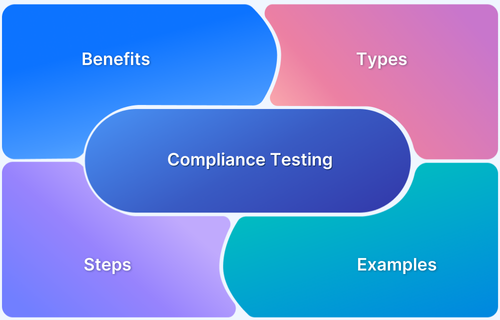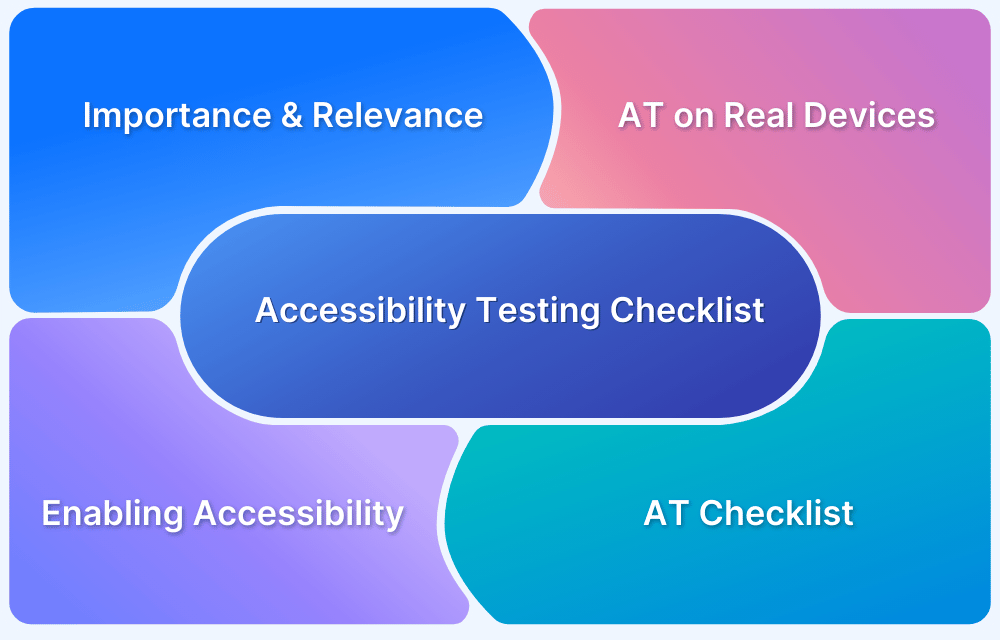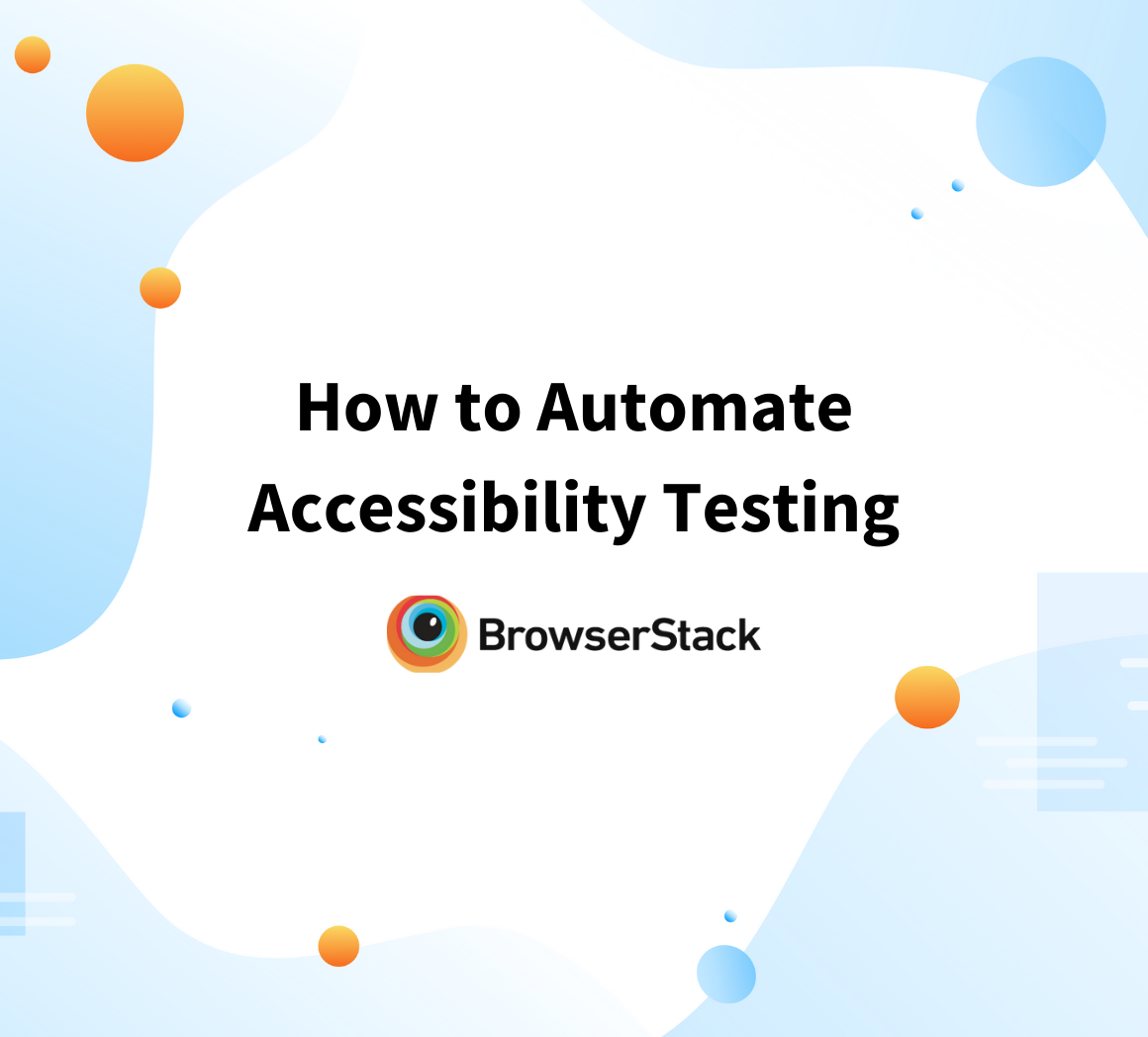People with disabilities should be able to use apps effectively, and compliance testing ensures these accessibility needs are met. It ensures that apps are designed to be inclusive and usable for everyone, regardless of their abilities.
Overview
What is compliance testing?
Compliance testing verifies that an application adheres to necessary legal, regulatory, and industry standards. This protects users, improves app security, and avoids legal consequences.
Benefits of compliance testing
- Prevents legal issues: Helps avoid fines and penalties by ensuring compliance with laws and regulations
- Boosts user trust: Ensures the app meets security, privacy, and accessibility standards
- Improves market readiness: Ensures apps are ready for release in global markets by meeting local compliance requirements
- Promotes quality assurance: Ensures high-quality apps by verifying they meet essential standards and guidelines
Types of compliance testing
- Accessibility testing: Verifies that the app is accessible to users with disabilities and adheres to guidelines such as WCAG 2.1.
- Internal testing: Verifies internal processes and standards are being met before external audits or reviews
- Security testing: Confirms the app meets security standards, protecting it from vulnerabilities and breaches
- Data privacy testing: Ensures the app complies with data protection regulations like GDPR
- Performance testing: Verifies the app performs optimally under various conditions while complying with performance standards
- Regulatory compliance testing: Checks if the app adheres to industry-specific regulations, such as HIPAA or PCI-DSS
This article explains the concept in detail, including when and how to perform compliance testing.
What is Compliance Testing?
Compliance testing refers to verifying whether a product, system, or process meets the required legal, regulatory, or industry standards. It ensures adherence to applicable rules and guidelines and that the product complies with relevant regulations or specifications.
Compliance testing is essential in highly regulated sectors such as healthcare, finance, and telecommunications. It verifies that a product, system, or process meets applicable rules and criteria, evaluates the subject against those standards, and documents the findings accurately.
For software, compliance testing ensures that the product adheres to coding standards, design specifications, and accessibility testing standards.
Why is Compliance Testing Important?
Compliance testing helps protect a company from financial penalties, litigation, and reputational damage. Below are some reasons why compliance testing is important.
- Detects non-compliance issues early, which mitigates risks, prevents penalties, and avoids disruptions
- Enhances business efficiency by resolving potential compliance issues
- Demonstrates a company’s commitment to high-quality practices by adhering to compliance standards
- Ensures businesses meet complex requirements, especially in highly regulated industries like healthcare and finance
- Protects against costly errors and supports sustained operations and a strong market reputation
Benefits of Compliance Testing
Below are some key benefits of compliance testing.
- Facilitates smooth international operations by ensuring compliance with region-specific regulations
- Promotes operational efficiency by addressing compliance issues proactively
- Reduces audit and review time by ensuring continuous compliance
- Prevents costly delays by identifying compliance gaps before they escalate
Types of Compliance Testing
Compliance testing has a wide scope and ensures that an organization runs according to its internal and external standards. Each type of testing focuses on different aspects of the organization’s operation to ensure that all areas comply with the appropriate standards and policies.
1. Accessibility Testing
Accessibility testing ensures that websites, web applications, or digital platforms offer equal access to everyone, including those with disabilities. It involves checking whether this design and usability align with accessibility standardization, such as the Web Content Accessibility Guidelines (WCAG) and section 508 of the Rehabilitation Act.
2. Internal Testing
Internal compliance testing ensures that a company’s digital applications align with its own internal policies, regulatory requirements, and industry standards. It involves evaluating the effectiveness of security measures, data handling practices, and adherence to application-specific guidelines.
3. Security Testing
Security compliance testing ensures that an organization’s systems, software, and data are protected against threats and breaches. It tests the security measures, such as encryption, authentication, and access controls, to determine whether they comply with industry standards, such as ISO/IEC 27001.
4. Data Privacy Testing
Data privacy testing ensures that their applications comply with data protection regulations such as GDPR (General Data Protection Regulation), CCPA (California Consumer Privacy Act), and others, depending on the jurisdiction. It verifies that personal data is collected, stored, processed, and transmitted according to legal requirements.
5. Performance Testing
Performance testing determines the performance of a system under different load conditions. This includes testing for scalability, reliability, and website loading speed to ensure the system can withstand peak loads and perform well in high-demand situations.
6. Regulatory Compliance Testing
Ensuring compliance with industry-specific regulations and government mandates includes adhering to data protection laws, financial reporting standards, accessibility regulations, and other requirements unique to the industry.
For example, regulatory compliance testing may involve ensuring compliance with laws like the Sarbanes-Oxley Act (SOX) or Anti-Money Laundering (AML) regulations in the financial sector. This helps minimize the risk of legal action, audits by regulatory agencies, and the potential loss of a license to operate.
When to Perform Compliance Testing?
Here are some instances when compliance testing becomes necessary.
- Periodically: Perform regular compliance tests (e.g., quarterly or annually) to maintain ongoing adherence to standards
- During development: Integrate compliance testing early in the development cycle to identify issues before deployment
- After updates or changes: Conduct testing after updates or system changes to ensure no new compliance risks are introduced
- Before regulatory audits: Conduct testing prior to audits or reviews to ensure compliance and reduce the risk of penalties
- New regulations adoption: Test compliance when adopting new regulations or entering new markets with specific legal requirements
- Integrating new technologies: Verify new tools or technologies integrate without creating compliance issues
Important Learnings About Compliance Testing
While compliance testing is important, the following criticisms must also be considered:
- High compliance tends to curb innovation, making it important to balance both
- Compliance testing needs a lot of resources, which can be challenging for smaller organizations
- Compliance testing focuses on meeting specific standards and may overlook vulnerabilities not covered by those standards
How to Perform Compliance Testing?
Follow these steps to perform compliance testing.
- Identify Relevant Regulations: Research the specific laws, standards, and guidelines relevant to your business.
- Compliance Criteria: Break down the regulations into clear, measurable testing criteria (e.g., data protection practices, security protocols).
- Selecting the tool for compliance testing: Select tools that align with the specific regulations and effectively cover the required scope of testing.
- Test execution: Test the system, processes, or software to assess compliance against the defined criteria.
- Review and Document the Results: Document results, non-compliance issues, and appropriate corrective action to ensure full compliance.
Compliance Testing for Mobile Applications
Compliance testing for mobile applications helps maintain user trust, protect data, and avoid legal consequences. The key focus areas for compliance testing for mobile apps include,
- Data Privacy: The app must comply with relevant data privacy regulations, such as GDPR, CCPA, or HIPAA. It should ensure user consent is obtained, minimize data collection, and allow customers to request data deletion
- Security standards: The application should implement AES-256 encryption for stored data, TLS 1.2+ for data in transit, and OAuth 2.0 for authentication and prevent API vulnerabilities
- Platform-specific guidelines: The app must meet Apple App Store and Google Play policies, including transparent data usage, permission disclosures, and UI/UX requirements to avoid rejection
- Accessibility: It should comply with accessibility standards to ensure usability for users with various disabilities
Follow-Up Read: Mobile App Accessibility Testing Checklist
Compliance Testing Examples
Below are some examples of compliance testing use cases:
1. Test Case: Accessibility Compliance
Test Objective: Verify the app’s compliance with accessibility standards such as WCAG 2.1 or WCAG 2.2.
Test Steps:
- Use screen readers like NVDA, VoiceOver, or JAWS to test compatibility
- Check if color contrast meets the accessibility requirements
Expected Results:
- All UI elements should be accessible via screen readers
- Text and background contrast should be sufficient for readability
Implementation Process
- Employ tools like Axe or Lighthouse to assess accessibility compliance
- Simulate various disabilities using tools like BrowserStack Accessibility testing to ensure the app’s usability for all users
- Document accessibility issues and track remediation efforts
2. Test Case: Data Encryption
Test Objective: Ensure that sensitive user data is encrypted in transit and at rest.
Test Steps:
- Verify that data is encrypted during transmission using protocols like TLS
- Check that stored data is encrypted using industry-standard algorithms such as AES-256
Expected Results
- Data should be unreadable during transmission and storage without proper decryption keys
Implementation Process
- Use security testing tools to analyze encryption implementation
- Ensure test cases use dummy data instead of real sensitive information to validate encryption mechanisms
- Create detailed reports on encryption compliance and potential vulnerabilities
3. Test Case: Regulatory Compliance
Test Objective: Verify that the application adheres to specific industry regulations, such as HIPAA (for healthcare applications) or PCI DSS (for payment security).
Test Steps
- Review the application’s data handling and storage practices
- Ensure that user access controls and audit logs are implemented per regulatory requirements
Expected Results
- The application should meet all regulatory standards, including data privacy and security measures
Implementation Process
- Utilize compliance management tools to assess adherence to regulations
- Simulate regulatory audits using automated compliance checks and security assessments
- Generate compliance reports for internal and external audits
Why Use BrowserStack for Compliance Testing?
BrowserStack Accessibility offers several advantages for performing compliance testing on mobile and web applications.
- Real-device testing: Test apps on real devices across various browsers and operating systems to ensure accurate, compliance-related results.
- Instant access to accessibility tools: Gain instant access to VoiceOver, NVDA, and Talkback on real desktop browsers and mobile devices to test accessibility and ensure full compliance.
- Audit accessibility issues: Audit accessibility issues on your page in a single scan and identify WCAG guideline violations by navigating your website like a user.
- Detailed issue grouping: Common issues are deduplicated, and unique issues are grouped by type, components, and WCAG violations for better analysis.
- Integration with CI/CD pipelines: Seamlessly integrate with your CI/CD pipelines to run compliance tests after each deployment, streamlining the testing process.
Conclusion
Compliance testing ensures that a website or mobile app meets all legal, regulatory, and security requirements. It covers data privacy, security, accessibility, and platform-specific requirements.
Tools like BrowserStack Accessibility allow you to test your website and apps on real devices and ensure they’re WCAG and ADA-compliant. Since the DOM is monitored automatically, it doesn’t require any maintenance and helps identify violations automatically.
Frequently Asked Questions
1. When to Use Compliance Testing?
Compliance testing should be considered when new releases or software updates are done to ensure the application complies with all legal, regulatory, and industry standards. It’s also important when conducting audits or reviewing changes in laws and regulations regarding your business.
2. Who carries out Compliance Testing?
Compliance testing is performed by quality assurance (QA) professionals or compliance experts. Even auditors from outside the organization can perform compliance testing to ensure industry compliance with regulations.
3. What to test in Compliance Testing?
The following should be tested in compliance testing:
- Data privacy (e.g., GDPR, CCPA)
- Security (e.g., encryption, authentication)
- Accessibility (e.g., WCAG 2.0)
- Platform-specific guidelines (e.g., Google Play, Apple App Store policies)
- Regulatory compliance (e.g., HIPAA, SOC 2)
4. Who sets the standards of Compliance testing?
Compliance testing standards differ with regulatory bodies and industry organizations. For instance, the GDPR outlines data protection standards, the OWASP security framework gives security requirements, and the W3C organization has set standards on accessibility.






